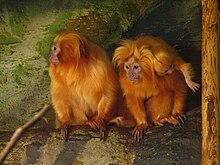Golden lion tamarin
| Golden lion tamarin | ||||||||||||
|---|---|---|---|---|---|---|---|---|---|---|---|---|

Golden lion tamarin ( Leontopithecus rosalia ) |
||||||||||||
| Systematics | ||||||||||||
|
||||||||||||
| Scientific name | ||||||||||||
| Leontopithecus rosalia | ||||||||||||
| ( Linnaeus , 1766) |
The golden lion tamarin ( Leontopithecus rosalia ), also called golden-yellow lion tamarin , is a primate species of the marmoset family (Callitrichidae).
features
Golden lion tamarins reach a body length of 26 to 33 centimeters, to which a 32 to 40 centimeter long tail comes. Their weight is around 570 to 620 grams. Their silky fur is predominantly golden yellow, the front paws and tail can be brown or black. The dark, hairless face is surrounded by a mane. As with all marmosets, the fingers and toes end in claws with the exception of the first toe of the hind paws.
distribution and habitat
Like all lion tamarins, golden lion tamarins are restricted to southeastern Brazil . Today they are only found in a small area in the state of Rio de Janeiro , earlier their range also extended to Espírito Santo . They inhabit tropical rainforests, mostly below 300 meters above sea level.
Lifestyle and diet
These primates are diurnal tree dwellers, at night they sleep in tree hollows or in the thicket of plants. They live in groups of two to eleven animals, mostly family groups, but they can contain several males and females. Social behavior within the group is very pronounced, and mutual grooming and sharing of food play an important role. Groups live in fixed territories of 30 to 60 hectares.
Golden lion tamarins are omnivores. They feed on fruits, flowers, insects, small vertebrates (e.g. lizards), nectar and bird eggs.
Reproduction
Only the highest-ranking female reproduces within a group. After a gestation period of around four months, the female usually gives birth to twins. The father and the other group members participate intensively in raising the young, they carry them around, occupy themselves with them and only give them to the mother to suckle.
From the fifth week of life the young animals become increasingly independent, at four months they are weaned. Sexual maturity occurs at 15 to 20 months, but due to the social structure, the first mating rarely takes place before the age of 30 months. Life expectancy is around 14 years.
threat
Like all four species of lion tamarins , the golden-yellow lion tamarin is threatened in its population, as it only occurs in the southeastern Brazilian rainforests, which have been badly affected by clearing. With the golden lion tamarin, however, breeding and resettlement programs are showing initial successes. The total population is estimated at over 1000 animals in the wild, one third of which comes from a resettlement program in the Poço das Antas Nature Park. Around 500 other animals are kept in human care. However, their distribution is fragmented and greatly limited by urban sprawl so that the IUCN the type as endangered (endangered) lists.
In 2014 and 2015 there were thefts of golden lion tamarins from the zoos of Amersfoort (5 animals), Saint-Aignan-sur-Cher (7 animals) and Krefeld (3 animals), presumably to sell them on the black market.
literature
- Thomas Geissmann : Comparative Primatology. Springer-Verlag, Berlin et al. 2003, ISBN 3-540-43645-6 .
- Ronald M. Nowak: Walker's Mammals of the World. 6th edition. Johns Hopkins University Press, Baltimore MD 1999, ISBN 0-8018-5789-9 .
Individual evidence
- ↑ Rare monkeys stolen from Amersfoort zoo www.nltimes.nl (English) from January 20, 2014, accessed on July 27, 2015
- ↑ 17 rare monkeys stolen from the French zoo www.zeit.de from May 12, 2015, accessed on July 26, 2015
- ^ Lion tamarins stolen from the zoo - high black market prices www.rp-online.de from July 25, 2015, accessed on July 26, 2015
Web links
- Leontopithecus rosalia in the endangered Red List species the IUCN 2009 Posted by: M. C. M. Kierulff, A. B. Rylands, M. M. de Oliveira, 2008. Accessed on 5 November of 2009.
- KA Cawthon Lang: Primate Factsheets: Golden lion tamarin ( Leontopithecus rosalia ) (English)
- Photos and information on arkive.org


